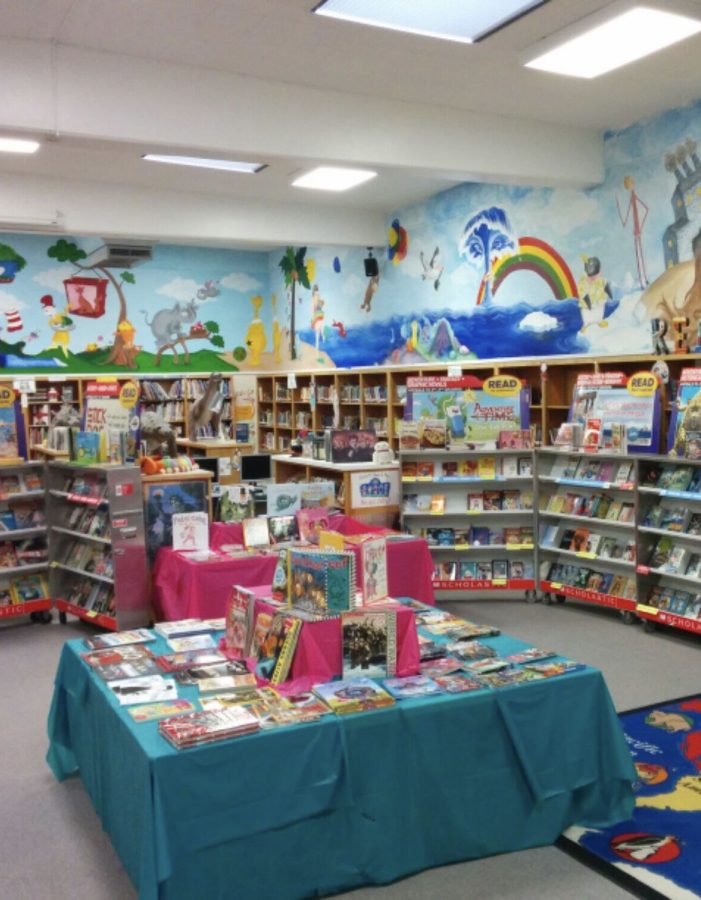Scholastic Book Fairs: how the inequalities outweigh nostalgia

More stories from Meghan Kennedy
A picture of an infamous Scholastic Book Fair set up in a school library.
Opinions expressed in editorials on The Central Trend are the view of the individual writer and are not the opinion of the entire staff of The Central Trend or the Forest Hills Central staff or administration.
On the surface, Scholastic Book Fairs are the annual events that allow young students to revel in the elation of new books and spreads of miscellaneous knickknacks, serving as the perfect recipe for nostalgia. But while the concept is innocent in theory, there is a complex layer of inequality rooted in these book fairs that prove to be a problem for families and communities.
For some children, the Scholastic Book Fair is the place to stock up on toys and glossy new books and simply absorb the pure, whimsical nature of it all. But for other kids, Scholastic Book Fairs propel them to the realization that they can’t afford these items when others can. While their peers stand at the checkout counter with armfuls of items, these kids are left to merely browse and watch.
The result of not being able to afford these books and toys is the weight of embarrassment, the feeling of exclusion, and the parental reactions that could potentially spur from it. Some parents might feel burdened with the pressure to shelter their children from this reality, so they spare them some extra money—money that they don’t necessarily have—to spend at these book fairs.
The actual items the money goes toward are not quite as useful or high-quality as one might think. Most of the time, the books are made out of cheap materials and have the tendency to break or rip within the early stages of use. The toys laid out to entice the children will end up inevitably purchased, furthering this insufficient use of money.
These books being sold also lack diversity and representation of groups and end up promoting large corporations and franchises rather than local businesses and diverse authors. Not to mention, the books and useless plastic toys being sold are exorbitantly overpriced, giving children a skewed perception of reasonably priced items.
“They only stock Scholastic books, which is a limited pool of titles, and often a huge percentage are franchise tie-in books (Star Wars, My Little Pony, LEGO, etc). They carry too many toys and other plastic nonsense. The $1 pencils and erasers I stand behind completely, but if you browse a Scholastic Book Fair flyer, you’ll see a lot of plastic junk included, some of which is quite pricey,” Danika Ellis wrote. “There is not a lot of flexibility in the books schools can request—although there is some wiggle room, it’s not much” (“The Inequality of Scholastic Book Fairs”, 2021).
Additionally, the funding for Scholastic Book Fairs is largely unequal. For well-funded schools, money coming in from children and their parents is continual fuel for the Scholastic Book Fair at that school. The thousands of dollars of remaining store credit allows for that specific school to continue to host the most abundant version of a book fair possible and rake in the cash.
However, in less affluent areas, the funding for Scholastic Book Fairs is limited, as the parents and students do not have as much money to give to these events. Since the store credit for these underfunded schools is already pretty low, the school usually has to spend all of the minimal credit on hosting the fair itself. This issue has solidified into a perpetual cycle; well-funded schools continue to bring in heaps of unneeded money from the fairs while poorly-funded schools don’t bring in enough money—money that they truly need—from the fairs.
The money that goes towards supporting these large corporations also subtracts from a community’s overall wealth. Since Scholastic is an independent company, the fairs that branch off from it bring in money from smaller communities. Instead of this money being contributed to local businesses—that end up circulating the money throughout the community—the money spent at Scholastic Book Fairs goes to the overarching company, subsequently draining those communities of capital. These book fairs are straying away from the purpose of being fundraisers and are rather morphing into a way to suck the money from communities in need.
Although there are many inequalities and problems tied to Scholastic Book Fairs, this is not a reason to entirely demonize them. They help to promote the love of books among children, allow students to discover preferences that encourage them to read, and additionally provide some children with positive, everlasting memories.
However, the beneficial things about Scholastic Book Fairs do not go unnoticed while the negative nuances completely fly under the radar. Many people are too absorbed in their nostalgia to dissect the problems of these book fairs, resulting in a greater amount of insensitivity and ignorance to oppressed groups.
In order to create more inclusivity in schools for students and families of varying income classes, these issues need to be addressed.

Meghan. also known as Meggie, is living up her senior year on The Central Trend. Starting out with a new role as Podcast Manager, Meggie is looking forward...




























































































Hannah • Mar 4, 2023 at 6:26 pm
After attending our school’s scholastic book fair I was disheartened to watch my kids spend $70 on 3 diaries and 2 novels. As a low income single parent home I struggle to provide an allowance of $10 a month for each child. And to watch months of savings be flushed on 5 items was disappointing. In contrast, I’ve taken my kids to library book sales where they easily purchase 200+ used books and DVDs for the same $70. Hoping my children learn the lasting lesson of smart shopping from this sad experience.